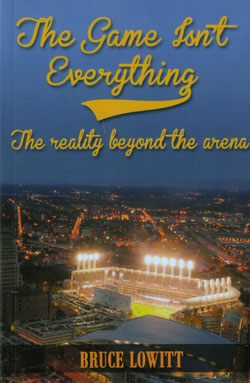The Game Isn’t Everything: The reality beyond the arena by Bruce Lowitt; Barstad Comminications; © 2015; 281 pages; 14.95.

 SAN DIEGO – I learned when I was a rookie reporter for the Associated Press back in 1967 that any fool, including yours truly, could write a story about an athletic contest. Essentially, you could make your lead (opening paragraph) about the game-winning moment, or about the person who contributed the most significant effort, and then you could build your story from there.
SAN DIEGO – I learned when I was a rookie reporter for the Associated Press back in 1967 that any fool, including yours truly, could write a story about an athletic contest. Essentially, you could make your lead (opening paragraph) about the game-winning moment, or about the person who contributed the most significant effort, and then you could build your story from there.
Some examples: “Irving Moskowitz batted three home runs accounting for 7 RBIs to lead the Brooklyn Pickle Packers today to an 11-2 victory over the Montana Bull Riders.” Or, “Shmuel Herschbein rocketed a 15-yard touchdown pass to Moshe “Zayde” Zeidman with only 12 seconds in the game remaining last night to vault Irving’s Synthetic Furs to a 13-7 inter-league victory over Herman’s-Jewelry-For-All-Occasions.
In The Game Isn’t Everything, Bruce Lowitt, who joined the AP in Los Angeles one day after I did, offers a collection of behind-the-scenes stories about the athletes, the venues, the disappointments, and the comebacks that make sports so much more interesting than who won or who lost.
Lowitt, who later joined the staff of the St. Petersburg Times, has a knack for writing human interest stories about the people in almost every spectator sport ranging from golf to football, and from women’s gymnastics to professional baseball. Yes, he writes about some of the big names in sports –people like the fabled Notre Dame football coach Ara Parseghian; New York Yankee home run slugger Roger Marris; stunt motorcyclist Evel Knievel; basketball legend Pistol Pete Maravich; and tennis star Jennifer Capriati.
But he also tells the stories of the not-so-famous like basketball player Danny Hurley, who never could emerge from the NBA shadow of his brother Bobby Hurley; Adam Raskin, a high school baseball coach fighting leukemia; and Ronald Sims, a minor league baseball player whose eye and career were shattered by a pitch that came too high and inside.
One of my favorite stories was about radio announcers and their signature calls for home runs: “They were simple yet dramatic,” Lowitt writes; “Harwell’s ‘It’s long gone!’ Kiner’s ‘It’s gone, goodbye!’ Caray’s ‘It could be, it might be, it is. A home run!” Prince’s ‘Kiss it goodbye!’ Hodges’ ‘Bye, bye baby!’”
Another of my favorite selections was when Lowitt teed off on the second-rate players and umpires offered as possible substitutes during the baseball strike. In a parody of “Casey at the Bat” by Ernest Thayer, Lowitt vented over 15 stanzas, ending with the following:
To a baseball fan, no tennis, golf or bowling stirs a glimmer
Of the passion that was fashioned by an Aaron or a Zimmer.
We won’t ever care one whit about those frauds, those drips, these drabs.
For a nation’s baseball fever can’t be cured or healed by scabs.
A remarkable writer blessed with menschlichkeit and a self-effacing sense of humor, Lowitt also tells stories on himself, such as the one about how twice he tried to impress the same girl by taking her out to dinner – and twice he found himself embarrassed by insufficient funds. No, I can assure you that girl was not Arlene, his wife of long standing and mother of his two grown children, Adam and Stephanie. After the second disastrous date, that girl—whoever she was—never went out with him again!
If you give a cheroot about sports, this book is one for you.
*
Harrison is editor of San Diego Jewish World. He may be contacted via donald.harrison@sdjewishworld.com